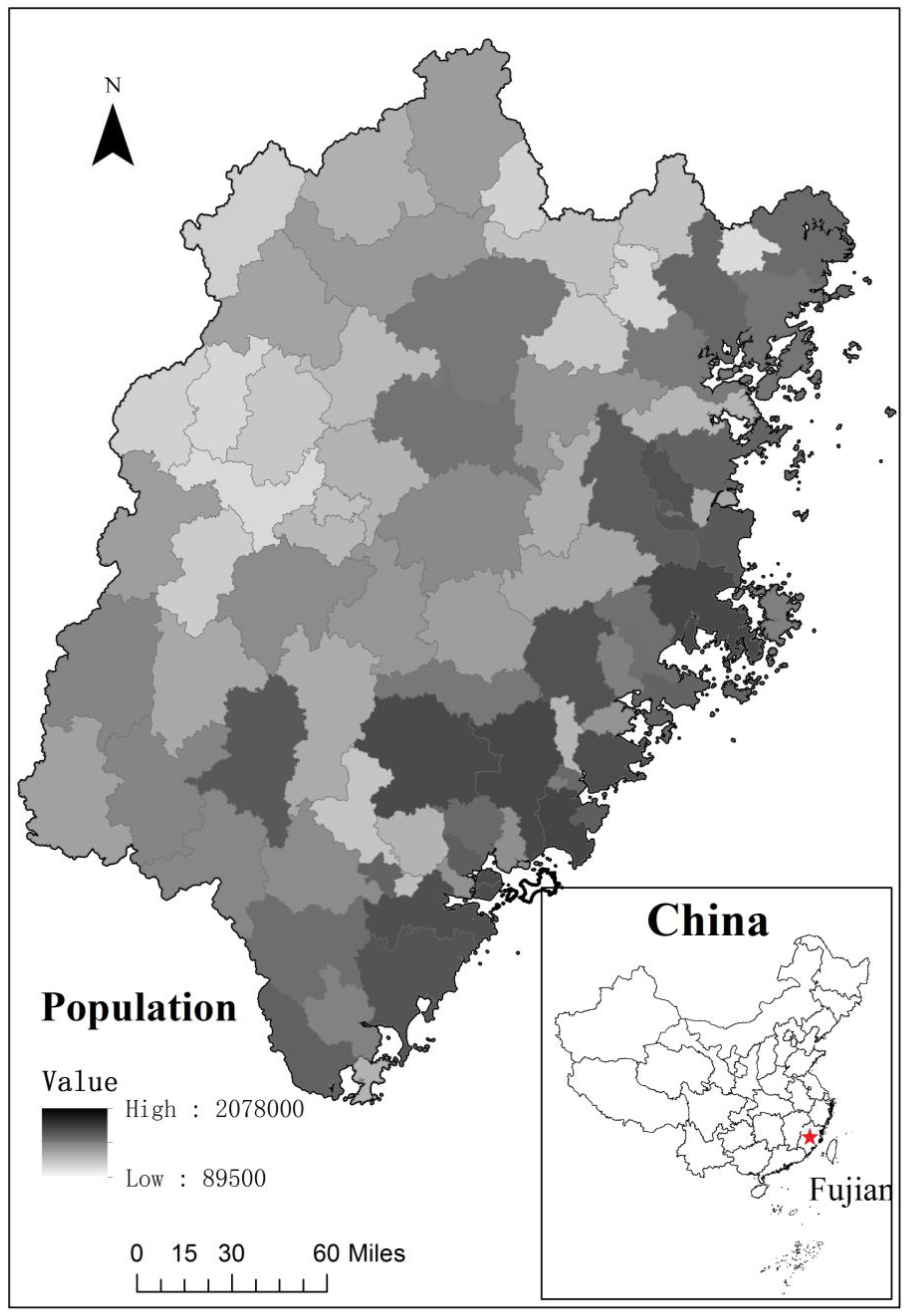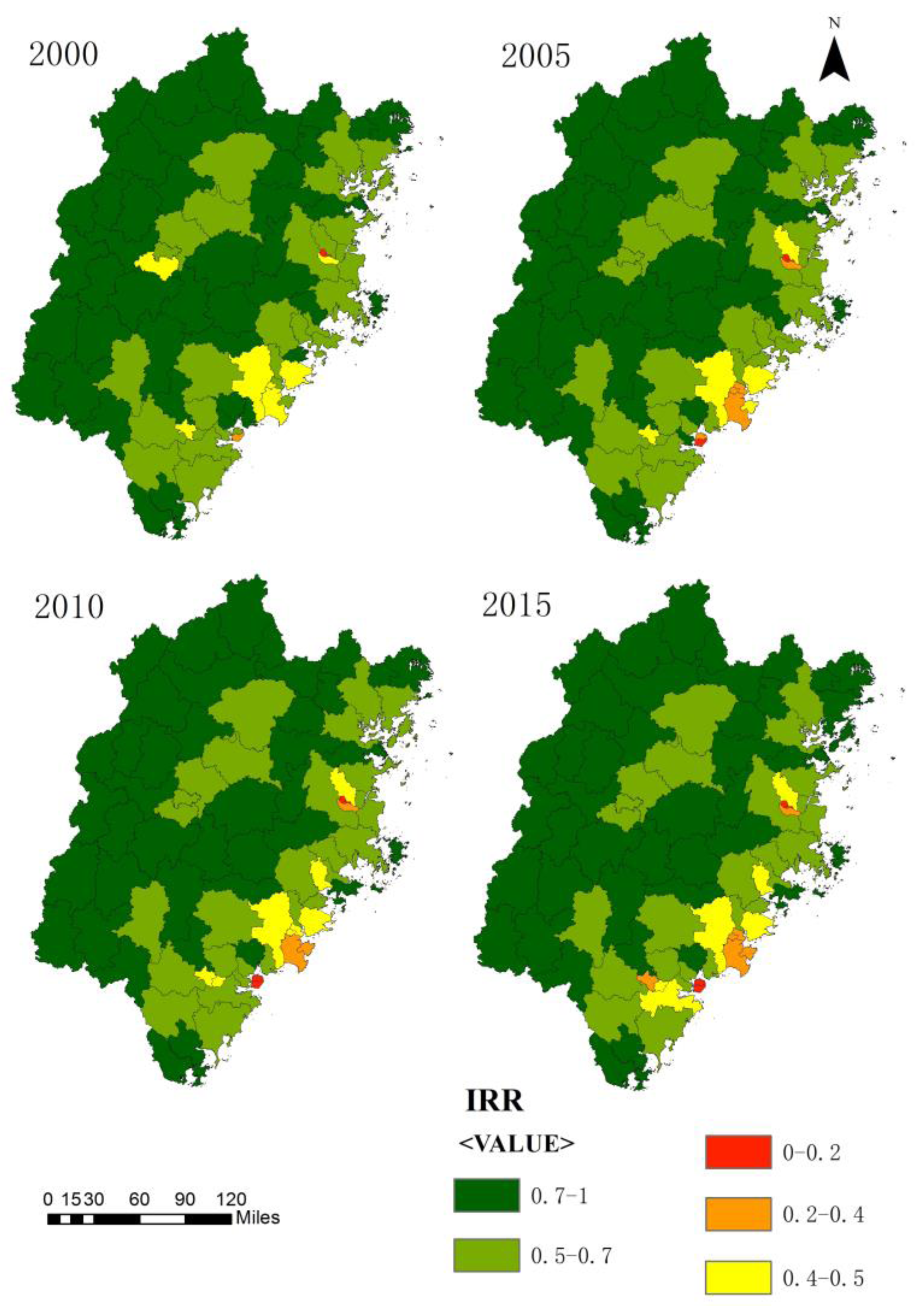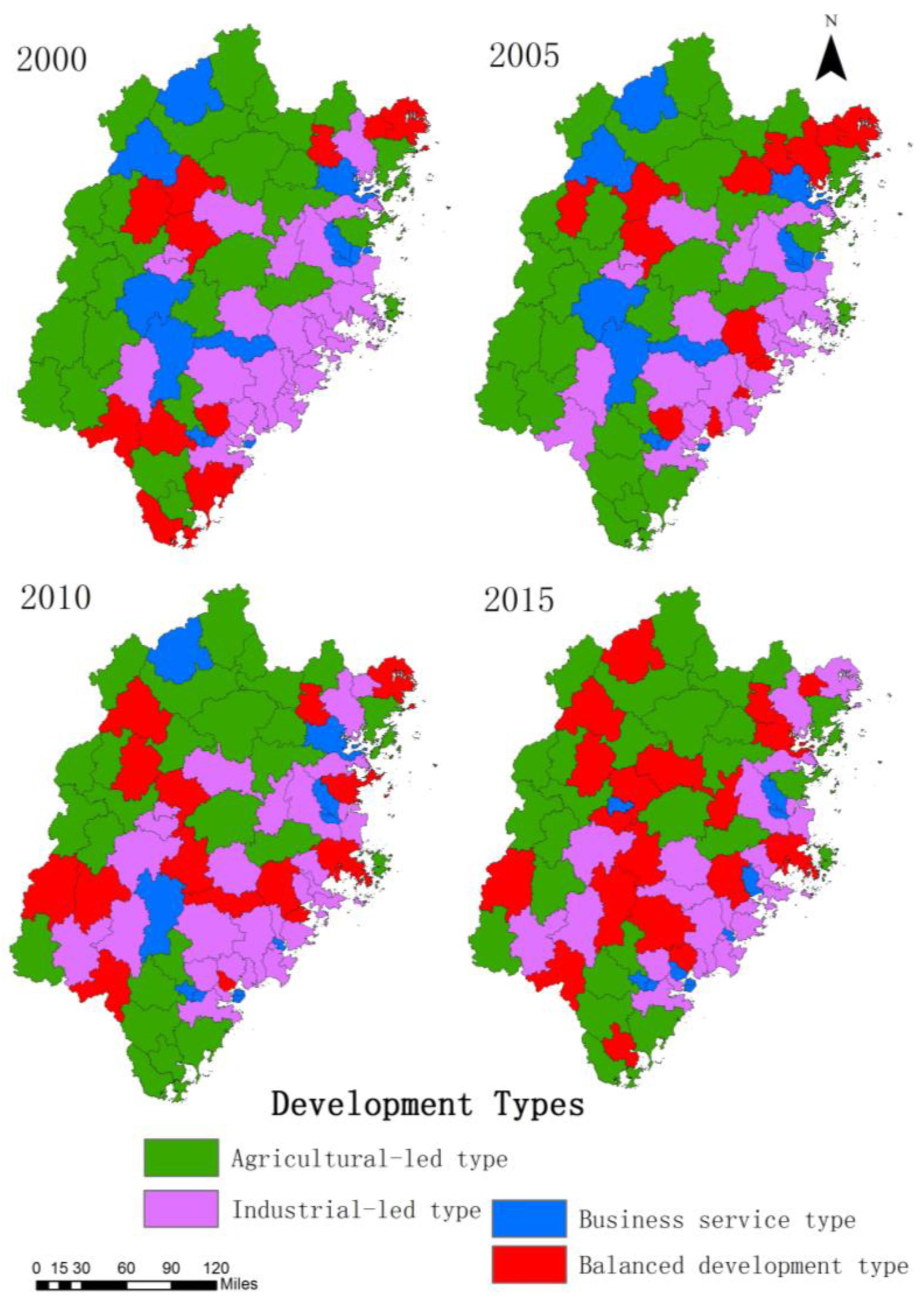2.2.1. Index of Relative Rurality
The Index of Relative Rurality (IRR) has been used to depict the degree of rural development, with greater IRR values indicating stronger rurality and a lower degree of urbanization. Previous research from our group used Waldorf’s [
19] (2006) IRR method to reveal the degree of development and characteristics of a rural area. For this study, we selected population size, population density, proportion of area of construction and degree of remoteness as four indicators, and with each indicator given the same weight, we calculated the county’s IRR in the research area during the period 2000–2015. The calculation method was as follow [
34]:
In Formula(1), stands for each county’s population size; stands for population density; stands for proportion of area of construction and stands for degree of remoteness. The degree of remoteness is defined as the minimum distance from the research area’s geometric center to the nearest urban area’s geometric center, as calculated through ArcGIS tools. The population size, population density and proportion of area of construction were negative indicators and the degree of remoteness is a positive indicator.
We calculated each county’s IRR over four periods during 2000–2015, and used an expert scoring method based on the results of previous studies to categorize the IRR values into five levels: very weak, weak, moderate, strong, and very strong [
35], as shown in
Table 2. In order to better show these differences in detail, we spatially mapped the categories using an equal interval method on ArcGIS.
As is the standard practice, the rural development type [
36] was characterized by the proportion of GDP accounted for by each broad industry category. Since the standard deviation value can reflect the degree of dispersion of a data set, if the relative proportion of the output value of an industry exceeds the sum of the mean value and standard deviation value of whole samples, it shows that the industry occupies the leading position in local economic development [
20]. We partitioned the development type of 84 counties in Fujian Province by calculating the percentage contribution of each industry’s output value to the region’s total economic output, then categorized the counties based on whether the proportion was greater than the sum of standard deviation value and the mean value of all the samples (
Table 3). If none of the proportions (GDP
1, GDP
2, GDP
3) are higher than the sum of standard deviation value and the mean value of all the samples, the county is categorized as belonging to the balanced development type. Thus, in this paper, the balanced development type means that agriculture, industry and business services coexist in a county, and no one of these is the leading industry.
2.2.2. InVEST Models
The Integrated Valuation of Ecosystem Services and Tradeoffs Tool (InVEST) was developed by the Natural Capital Project [
37]. It is a comprehensive suite of models used to quantify and value ecosystem services (ES); it has been applied in North America, China and other regions and has provided some useful simulation results under different land use change and development scenarios [
37]. One advantage of using the InVEST models to calculate ecosystem services is that the results can be directly used to analyse the spatial distribution and heterogeneity of an ecosystem service. Additionally, the protection of natural resources and the relationship between natural resources and economic development can be weighed using the model’s scenario simulations and comparisons of ecosystem service gains and losses, which can assist decision makers by providing a scientific basis for decision-making [
9].
In this study, based on the availability of basic data, we chose to investigate three ecosystem services, carbon storage, habitat quality, and annual water yield, which represented a regulating service, a support service and a provisioning service, respectively. Since the calculation processes used in InVEST models are complex, the data requirements and model operations are not described in detail in this paper. Detailed methods and the manual for InVEST models are available at the InVEST website,
https://www.naturalcapitalproject.org/invest/. Briefly, the calculation methods are as follows:
The carbon density refers to the amount of carbon stored per unit area, and it reflects the carbon storage capacity of ecosystems. The model calculates the ecosystem carbon storage by multiplying the average carbon density of a land type by the area under that land type; this is based on the average densities of four types of carbon pools–above ground, below ground, soil and litter–in different land types. The formulation is as follow:
In Formula (2), means total carbon storage, means carbon storage above ground, means carbon storage below ground, means soil organic carbon stock, means dead (litter) organic carbon stock.
The habitat quality module combines the sensitivity of each landscape type and the intensity of external threats to obtain the distribution of habitat quality and assess the status of biodiversity according to the quality of habitat. It assumes a high level of biodiversity in areas where the quality of habitats is good. Habitat quality can be understood as the potential for ecosystems to provide the conditions needed for species to survive and multiply. The quality of habitat is reflected by the habitat quality index, and the formulation is as follow:
In Formula (3), is the habitat quality for grid x in grid j in land use and land cover, is the level of threat on grid x in grid j in land use and land cover, x is the half-saturation constant, which usually takes half of the maximum value in , is the habitat suitability for type j in land use and land cover, and z is a normalized constant value, which is usually taken as 2.5.
The water supply service refers to the amount of surface water that can be produced in a certain area. The more water produced, the better the water supply. The water yield model of InVEST estimates water balance, including surface runoff, soil moisture content, litter water holding capacity and canopy interception volume. The calculation of water yield in the model is as follow:
In Formula (4), is the average annual water production of the grid x, is the annual average precipitation of the grid x, is the annual average evaporation of the xth grid of the jth land use and land cover type.
We used InVEST models to evaluate the carbon storage, habitat quality, and annual water yield within our study area, and obtained grid figures with 30m × 30m resolution for each of these three ecosystem services. Then, because the maps were not in the same units, we standardized the data in the three maps and overlapped them using the overlay analysis union tools within ArcGIS, then normalized the data to obtain a map displaying values between 0 and 1. The normalization method is as follow:
In Formula (5), is the new value of ecosystem services at grid i, is the overlapped value of ecosystem services at grid i, and are the maximum and minimum of the overlapped ecosystem services value at grid i.
Since higher scores indicate better services for all three ecosystem services, this score can indicate the quality of ecosystem services provided. Finally, we used the zonal statistics of the spatial analyst tools in ArcGIS to obtain the counties’ mean value. In order to better show differences in detail, we also spatially mapped categories of ecosystem services in the research area using the equal interval method on ArcGIS.
2.2.3. Coupling Degree
In this paper, we investigated the coupling between ecosystem services and relative rurality. From the perspective of Synergetics, the degree of coupling and coordination determine the order and structure of the system when it reaches a critical region, or the tendency of the system to go from disorder to order [
29]. The internal variables of the system at the phase transition point can be divided into two types: fast and slow relaxation variables. The slow relaxation variable determines the phase change process of the system, that is, the order parameter of the system. The key of the system from disorder to order lies in the synergy between the order parameters in the system, and this synergy influences the characteristics and laws of the phase transition. The coupling degree (C) is just a measure of this synergy [
38]. Therefore, the degree to which rurality and ecosystem services influence each other through their respective coupling elements can be defined as the rurality-ecosystem services coupling degree.
In Formula (6),
are the order parameters of the rurality-ecosystem services system, and their values are
(the formula refers to each county’s rurality value and ecosystem services score separately). The
and
are the upper and lower limits of order parameters in the system stability critical point (the maximum and minimum value of rurality and ecosystem services). Thus, the efficiency of the rurality-ecosystem services system which ordered to whole system is as follow:
In Formula (6), is the contribution of variable to the whole system. The efficacy function can reflect the satisfaction of each target to achieve the goal, when = 0, it’s the most dissatisfied, and when = 1, it’s the most satisfied .
Since rurality and ecosystem services are different but interacting subsystems, the “total contribution” to the orderliness of each order parameter in the subsystem can be obtained through an integrated approach [
39]. In this paper, we use the geometric average law and the linear weighted sum method.
In Formula (7),
is the total order parameter of subsystem to whole system,
is the weight of each order parameter,
is the stable area of the system [
40].
Based on the definition of capacity coupling and capacity coupling coefficient model in physics
[
41], we can promote the coupling model of the interaction of multiple systems [
42]. The formula for the coupling model is as follows:
In Formula (8), indicates the general parameters of the subsystems to the total system, is the comprehensive sequence parameters of rurality index, is the order parameter of ecosystem services, and C is the coupling degree.
We used the median segmentation method to divide the coupling degree into four intervals, which are based on the intervals used in previous research [
26,
43]. When 0 <
C ≤ 0.3, we consider the system to be in the “low-level coupling” stage, in which it has high rurality and good ecosystem services. The ecosystem can fully bear the consequences of rural development at this stage. When 0.3 <
C ≤ 0.5, it indicates that the system is in an “antagonistic” stage in which the rapid development of rural areas causes the decline of ecosystem services; thus, both rurality and ecosystem services values are declining. When 0.5 <
C ≤ 0.8, we consider the system to be in the “run-in” stage in which the two subsystems begin to benignly couple and the value of ecosystem services begins to improve. This may occur when protection and maintenance of ecosystem services are considered during the rural development process. When 0.8 <
C ≤ 1, it indicates that the system is in a ‘high-level coupling” phase, in which the two subsystems develop together and promote each other; thus, the system develops a high level of ecosystem services coexisting with low rurality (urbanization).
The coupling degree can be used to determine the strength of the coupling between rurality and ecosystem services and the timing interval of their functions. However, the coupling degree does not always reflect the “efficacy” and “coordination” of the two systems as a whole, especially in the case of comparative studies over multiple areas that have interlaced, dynamic and unbalanced characteristics. Thus, we used the coupling coordination degree (
D) to evaluate the degree of coordination of rurality-ecosystem services interaction in the area. The formula is as follows:
In Formula (10),
is the coupling coordination degree,
is the compatibility index, which reflects the overall coordination or contribution of rurality-ecosystem services;
a and
b are the specific coefficients, generally taking
a,
b to 0.5. Likewise, the coupling coordination degree was graded into four intervals used the median segmentation method [
26,
44]. When 0 ≤
D < 0.4, the coordination degree is considered low; 0.4 ≤
D < 0.5 is considered moderate coordination; 0.5 ≤
D < 0.8 is considered high coordination; 0.8 ≤
D < 1 is considered excellent coordination, which means rurality and ecosystem services coordinative well to each other.
We also used correlation method of Pearson to calculated the correlation between IRR and ES by simple correlation analysis in Statistical Product and Service Solutions (SPSS) (SPSS China, Shanghai, China), and we used regression analysis to investigate the linear relationship between IRR and ES.










